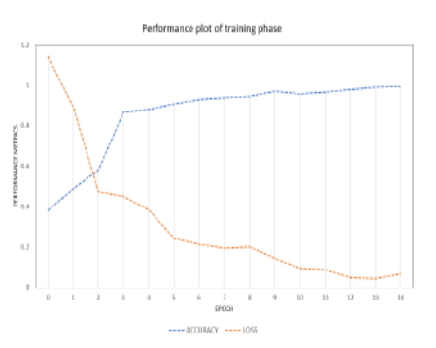


Indian Journal of Science and Technology
Year: 2024, Volume: 17, Issue: 1, Pages: 70-79
Original Article
T S Chandrakantha1*, Basavaraj N Jagadale1, Omar Abdullah Murshed Farhan Alnaggar1
1Department of PG Studies and Research in Electronics, Kuvempu University Jnana Sahyadri, Shankaraghatta, Shimoga, 577451, Karnataka, India
*Corresponding Author
Email: [email protected]
Received Date:03 November 2023, Accepted Date:10 December 2023, Published Date:05 January 2024
Objectives: This study aims to employ a hybrid Deep Learning (DL) technique for automating tumor detection and classification in lung scans. Methods: The methodology involves three key stages: data preparation, segmentation using Fuzzy C Means (FCM), and classification using a hybrid DL model. The image dataset is sourced from the benchmark Lung Tumor (LT) data, and for segmentation, the FCM approach is applied. The hybrid DL model is created by combining a Pulse Coupled Neural Network (PCNN) and a Convolutional Neural Network (CNN). The study utilizes a dataset of 300 individuals from the NSCLC-Radiomics database. The validation process employs DICE and sensitivity for segmentation, while the hybrid model's confusion matrix elements contribute to performance validation. FCM and the hybrid model are employed for processing, segmenting, and classifying the images. Evaluation metrics such as Dice similarity and Sensitivity gauge the success of the segmentation method by measuring the intersection between ground truths and predictions. After segmentation evaluation, the classification process is executed, employing accuracy and loss in the training phase and metrics like accuracy and F1-score in the testing phase for model validation. Findings: The proposed approach achieves an accuracy of 97.43% and an F1-score of 98.28%. These results demonstrate the effectiveness of the suggested approach in accurately classifying and segmenting lung tumors. Novelty: The primary contribution of the research is a hybrid DL model based on PCCN+CCN. This ultimately raises the quality of the model, and these are carried out using real-time public medical images, demonstrating the model's originality.
Keywords: Lung, Tumor, Segmentation, Classification, Hybrid model
© 2024 Chandrakantha et al. This is an open-access article distributed under the terms of the Creative Commons Attribution License, which permits unrestricted use, distribution, and reproduction in any medium, provided the original author and source are credited. Published By Indian Society for Education and Environment (iSee)
Subscribe now for latest articles and news.